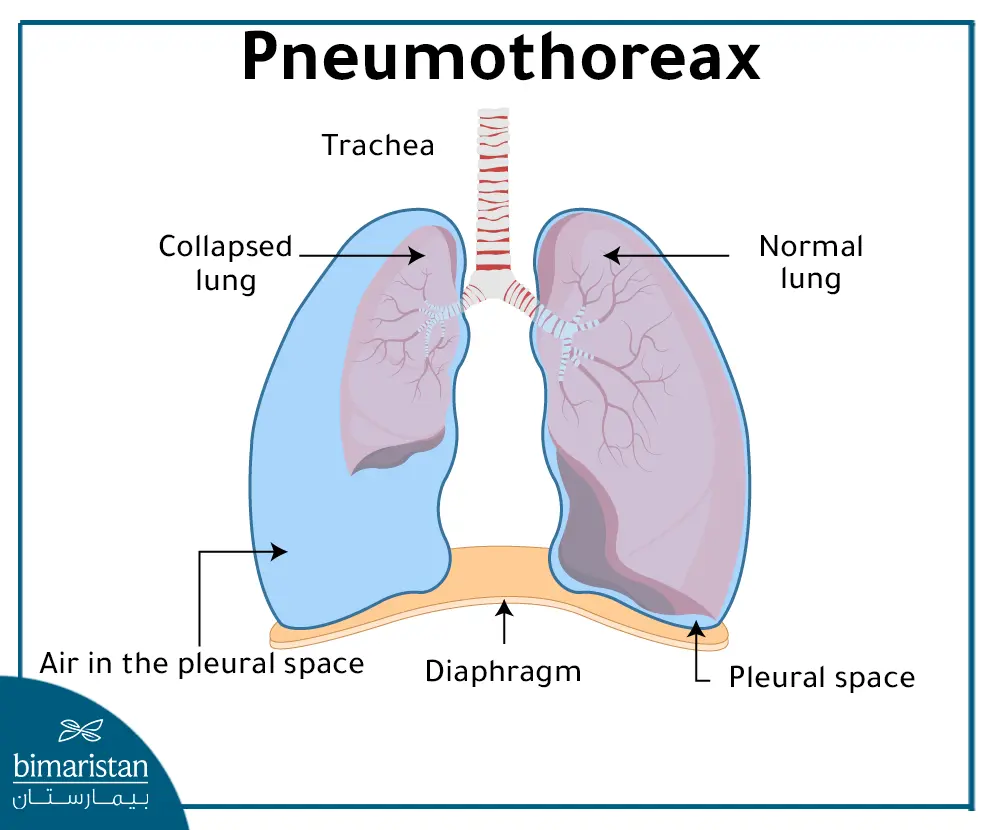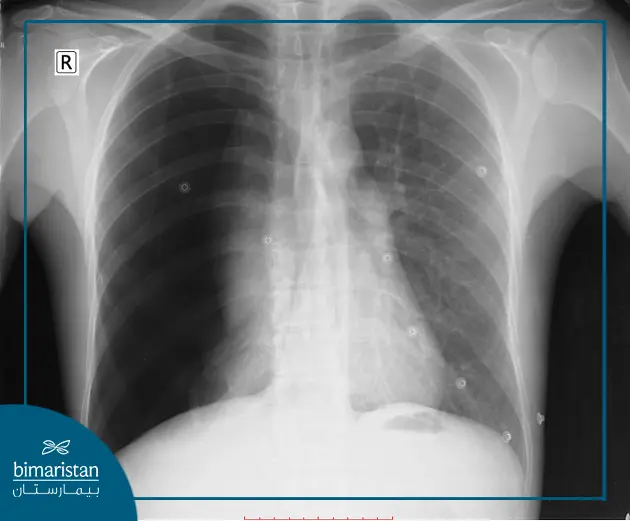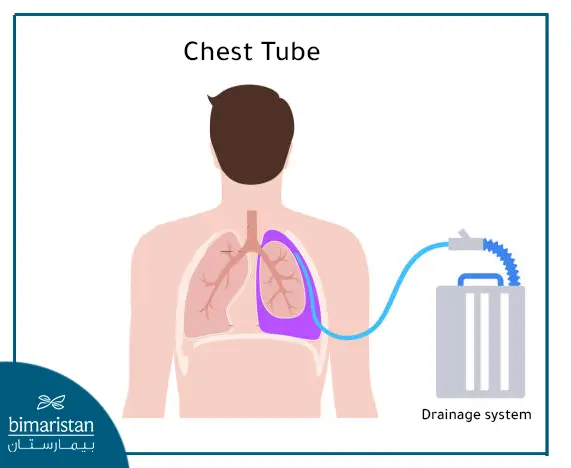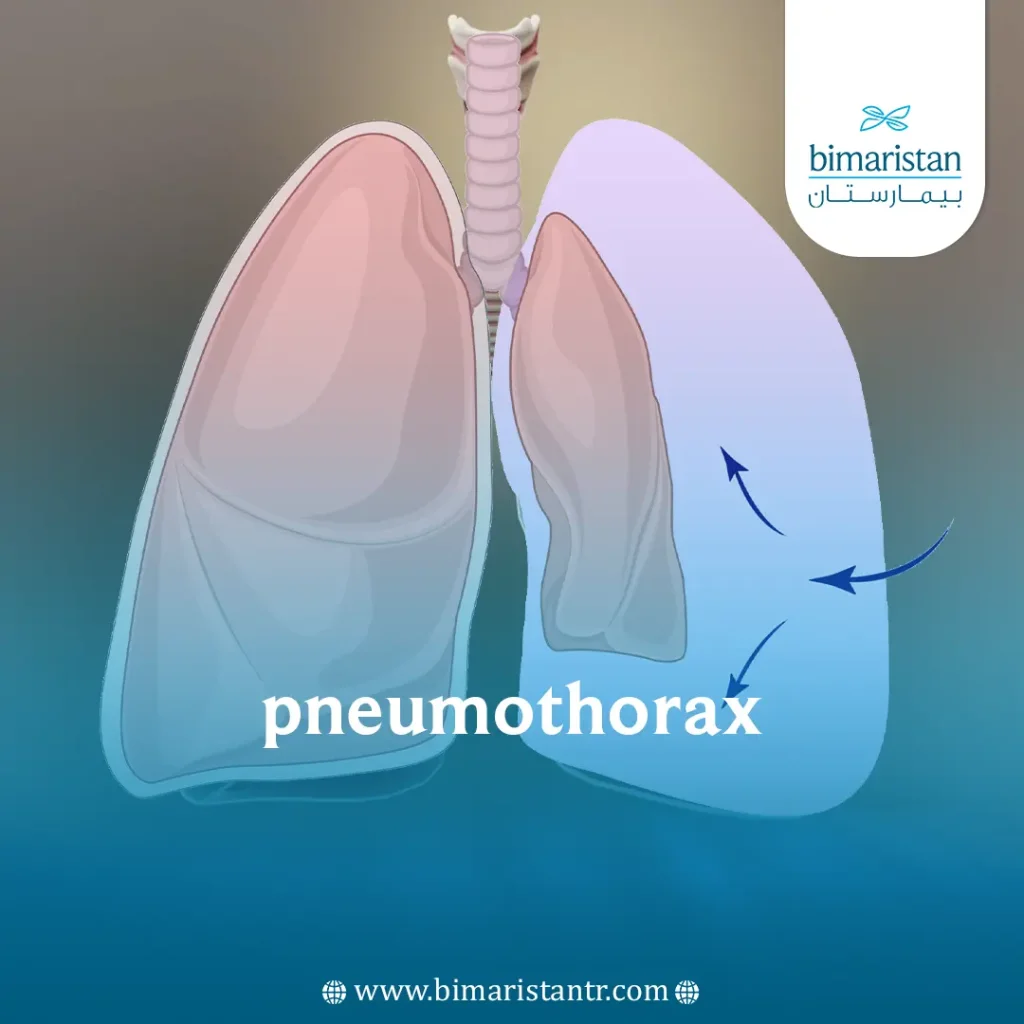Chest compression pneumothorax is a life-threatening emergency caused by air accumulation between the lung and chest wall, requiring immediate treatment.
Pneumothorax, also known as collapsed lung or punctured chest, is the accumulation of air in the pleural space surrounding the lung directly (between the visceral and parietal pleura). This air increases the pressure inside this space, compressing the lung and preventing it from expanding during inhalation, causing the patient to experience shortness of breath and chest pain.
It can result from various causes. In this article, we will take a look at the causes and symptoms of the punctured chest, along with available treatment options for this condition and ways to prevent it.

Types of Pneumothorax
Due to the various possible causes of punctured chest, it is necessary to classify it based on the underlying factors as follows:
- Spontaneous Pneumothorax: This is the most common type, and its mechanism is unclear and rarely associated with another lung disease.
- Traumatic Pneumothorax: Results from trauma to the chest with a sharp object (such as a knife) or a blunt object (like a stick), causing a significant air accumulation that hinders breathing, known as “Tension Pneumothorax.”
- Iatrogenic Pneumothorax: Occurs as a result of therapeutic or diagnostic surgical interventions, such as placing a patient on a mechanical ventilator or undergoing chest surgery, making them susceptible to a punctured chest after the procedure.
Causes of Pneumothorax
The occurrence of punctured chest is linked to various causes and diseases. Therefore, it is important to consult a doctor to determine the precise cause and provide appropriate treatment. Some of the causes include:
- Penetrating and blunt trauma to the chest wall
- Central venous catheterization, such as the jugular vein
- Post-surgical interventions on the trachea, thyroid gland, or kidney
- After bronchoscopy, lung resection, or any chest surgery
- Inflammatory conditions such as pulmonary tuberculosis and lung abscess
- Bronchial tumors and air cysts
- Chronic diseases like asthma, chronic obstructive pulmonary disease (COPD), and pulmonary emphysema
- Chest wall deformities, such as pectus excavatum and pectus carinatum
- Immune-related conditions related to exposure to chemicals or environmental pollutants can cause irritation in the respiratory system.
Symptoms of Pneumothorax
The symptoms of pneumothorax depend on its cause and severity. One of the most common and significant symptoms is severe respiratory distress (difficulty breathing), present in about 60% of patients.
In addition to the feeling of intense stabbing chest pain, which may radiate forward or downward and can be mistaken for the pain of a perforated peptic ulcer or angina, there may be a dry cough. It is worth noting that these symptoms typically start suddenly and are unrelated to exertion, especially in tension pneumothorax. People around the patient may notice difficulty breathing, and the patient’s face may turn blue, prompting them to call emergency services immediately.
Diagnosis of Pneumothorax
Early and prompt diagnosis of a punctured chest is crucial due to its life-threatening nature, the diagnosis is carried out through several steps:
- The doctor inquires about the patient’s symptoms, their progression, and the patient’s medical history, including any relevant past medical conditions.
- The physician examines the chest and lungs using a stethoscope, applying pressure to the chest to listen for breath sounds. The absence of these sounds on one or both sides directs towards the diagnosis.
- Blood analysis is used to determine oxygen and carbon dioxide levels, and sputum samples are examined to identify any infections or inflammation in the lungs.
- A simple chest X-ray (CXR) is performed; in some cases, computed tomography (CT) imaging may be used to identify any structural changes in the lungs.

Medical treatment for pneumothorax
The treatment primarily depends on the degree of punctured chest and the amount of air within the pleural cavity. Treatment options for a punctured chest include:
Pneumothorax supportive therapy (Observation)
If the pneumothorax is less than 25% of the chest volume, the lung spontaneously expands by about 1.25% per day. A simple pneumothorax usually requires about two weeks to heal and is monitored radiographically during this period. The patient’s condition may deteriorate during monitoring, so oxygen can be used to accelerate lung expansion. We may resort to a thoracentesis using a thin needle, often in the second intercostal space (between the second and third ribs).
Pneumothorax treatment by Closed Underwater Drainage
This involves inserting a flexible tube into the pleural cavity through the fifth or sixth intercostal space under local anesthesia to drain the compressed air from the lung. This is performed when the pneumothorax is more than 25%. Recovery typically takes 3-5 days, possibly up to 10 days. The absence of air bubbles from the drainage tube and the return of normal chest sounds on auscultation, along with full lung expansion radiographically, are essential signs of recovery.

Pneumothorax therapy Pleurodesis
This procedure aims to create adhesions between the pleural layers, preventing the recurrence of air accumulation. It can be done surgically or by using various substances such as talc powder, tetracycline, hypertonic saline solution, silver nitrate, and others. Pleurodesis is considered when surgery is not possible due to the patient’s intolerance or refusal.
Surgical Treatment of Pneumothorax
In surgical intervention, the parietal pleura is excised, and the air bubble is removed. Video-assisted thoracoscopic surgery (VATS) can be used for the excision of the air bubble and pleurodesis. The success rate of pneumothorax treatment and surgery is around 100%. Surgery is reserved for cases where:
- Recurrence of the punctured chest after treatment (recurrent pneumothorax) three times or more.
- Failure of closed drainage and continued air leakage for more than 10 days.
- Patients exposed to atmospheric pressure changes (air travel, swimming).
- Patients whose respiratory condition does not tolerate recurrence.
- Elderly patients with tension punctured chest.
- Increasing blood effusion (more than 1.5 liters) accompanying punctured chest.
- A large air cyst or hydropneumothorax causes pneumothorax.
- Previous injury to both sides.
Complications of Pneumothorax
A collapsed lung is considered a serious medical condition due to life-threatening complications, necessitating immediate medical intervention to preserve the patient’s life. Complications include:
- Respiratory failure (inability to breathe altogether).
- Pneumomediastinum occurs if air moves into the space around the heart.
- Pneumoperitoneum if air moves into the space around the abdominal organs.
- Pulmonary barotrauma.
- Hemorrhagic pleural effusion.
- Compression of the heart and major blood vessels, potentially leading to a heart attack.
- Death, especially in the case of tension punctured chest.
Prevention of Pneumothorax
Due to the severity and life-threatening nature of the disease, it is important to adhere to medical guidelines and advice to prevent chest wind complications, including:
- Avoid exposure to factors that can cause chest wind, such as smoke and environmental pollution.
- Stay away from individuals with contagious diseases such as influenza and the common cold.
- Maintain a healthy and balanced diet and engage in regular exercise to promote respiratory health.
- Avoid exposure to extreme cold by wearing warm clothing in cold weather.
- Prevent allergies by avoiding respiratory irritants such as dust and pets.
- Ensure that you receive important vaccinations, such as the influenza vaccine, to strengthen the immune system and reduce the risk of infectious diseases.
In conclusion, patients should remember that good medical care and adherence to treatment can mitigate the effects of pneumothorax on their daily lives. With ongoing advancements in the field of medicine and treatment, patients can hope for an improvement in their condition and achieve a better quality of life. Therefore, seeking medical assistance and following medical instructions is crucial for the best possible outcomes.
Sources:

